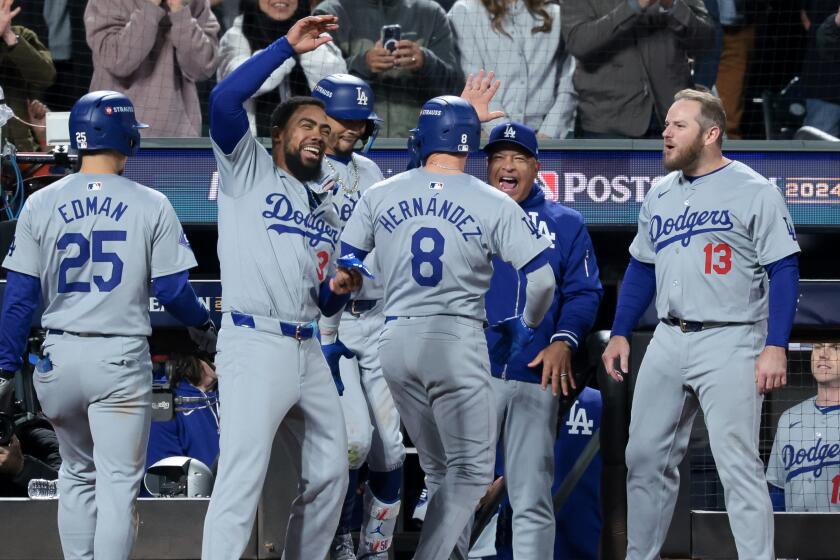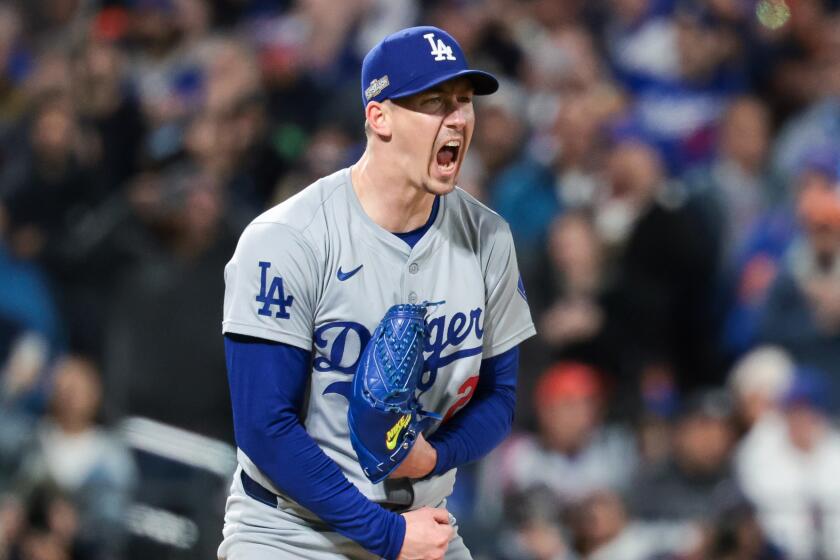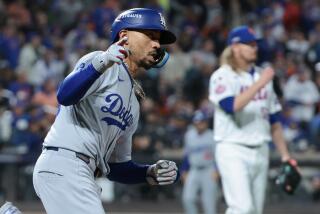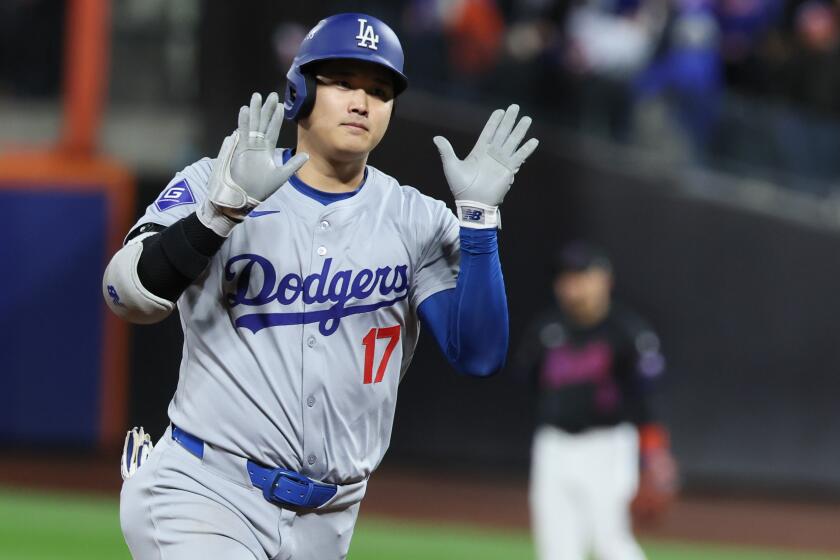
NEW YORK — Walker Buehler held his glove up to his chest and screamed into the October night.
Bases loaded, two outs, full count and Buehler had struck out Francisco Lindor with … a curveball?
On what turned out to be the most important pitch in an 8-0 victory over the New York Mets in Game 3 of the National League Championship Series, Buehler revealed the kind of pitcher he could be moving forward.
By contributing four scoreless innings in a win that resulted in a two-games-to-one series lead for the Dodgers, Buehler demonstrated the gradual transformation he made over the most testing season of his career.
Nothing encapsulated Buehler’s evolution as much as his second-inning strikeout of Lindor, which preserved a two-run lead.
With the Dodgers dominating the Mets in Game 3 of the NLCS, there’s a good chance the Dodgers can wrap up the series before it would head back to L.A.
“Right there,” manager Dave Roberts said, “was the pitch of the game.”
There was a time when Buehler wouldn’t have even considered throwing an off-speed pitch in that situation.
“Oh, in 2018, 2019, 2020, I would have thrown a fastball,” Buehler said with a smile.
Back then, he was nicknamed Butane. He attacked hitters with a high-90s fastball and hit-it-if-you-can attitude.

He returned this season from his second Tommy John surgery and was a changed pitcher. His fastball wasn’t as explosive.
He still had trouble betraying his instincts.
In mid-June, the Dodgers were visited by the defending World Series champion Texas Rangers. Buehler started the middle game of a three-game series. By this point he was less reliant on his four-seam fastball than ever.
But in the fifth inning, he encountered a situation similar to the one he faced Wednesday night: one-run lead, two men on, full count, and one of baseball’s most feared hitters at the plate.
The hitter in question was Corey Seager, who was the World Series most valuable player when Buehler was the No. 1 starter for the Dodgers’ championship team in 2020.
Buehler threw Seager a 96-mph fastball. Seager launched the pitch halfway up the right-field pavilion. The Rangers went on to win the game.
Asked how the pitcher who threw that fastball to Seager became the pitcher who threw this curveball to Lindor, Roberts replied, “I think it’s been a lot of lessons that he’s had to learn, and appreciating, understanding the pitcher he is today.”
And what did Buehler learn?
“That with 3-2 and the bases loaded, I have to throw a curveball now instead of a heater,” Buehler said.
He smiled.

Buehler was self-effacing in his postgame news conference, joking about what he thought when Lindor came to the plate: “I think the fear of pitching the way I pitched all year is probably where I channel it from.”
There were sincere moments as well.
Buehler entered the interview room at Citi Field as Kiké Hernández was about to answer a question about, you guessed it, Buehler.
Standing in the corner of the room, Buehler nodded as Hernández talked about how comfortable he is on the big stage. He looked down when Hernández explained how much the players trusted him.
Buehler later explained how important that was to him.
Walker Buehler provides a strong start and Kiké Hernández and Shohei Ohtani hit home runs to power the Dodgers to an 8-0 win over the Mets in NLCS Game 3.
“The way Kiké talks about our team having some sort of confidence when I pitch, I think, is kind of really the goal for any starting pitcher,” he said. “There’s the stats and free agency and all this [stuff], but I want 25 guys in the locker room that believe I give us a really good chance to win. If I’ve created that in our locker room somehow, that’s probably what I’ll be most proud of when I’m done.”
At this point, at the end of his first year back from his second elbow reconstruction, Buehler doesn’t have any delusions of his capabilities. He didn’t complain about being removed from the game after four innings — his pitch count already was 90 — because the Dodgers didn’t need him to pitch six-plus innings like they once did. The next three innings were covered by Michael Kopech, Ryan Brasier and Blake Treinen. Once Shohei Ohtani blew open the contest with a three-run home run in the eighth inning, Roberts called on rookie Ben Casparius to finish the game.
Buehler was satisfied to just have the moment he did against Lindor.

“When you talk about the surgeries and the road and all of that stuff, I think being able to make a big pitch in a big spot is kind of the last thing you check off, but the one thing you want to check off more than anything,” Buehler said. “And tonight that was a big deal for me.”
Before striking out Lindor, the last such moment he could recall was in Game 6 of the 2020 NLCS against the Atlanta Braves. The Braves loaded the bases with no outs in the second inning. Buehler struck out the next two batters and forced a third to ground out to short. Of the 13 pitches he threw to those three hitters, 11 were fastballs, including 10 in a row.
Wednesday night, on the same stage, he escaped a comparable threat. The way he did it was entirely different.
More to Read
Are you a true-blue fan?
Get our Dodgers Dugout newsletter for insights, news and much more.
You may occasionally receive promotional content from the Los Angeles Times.













